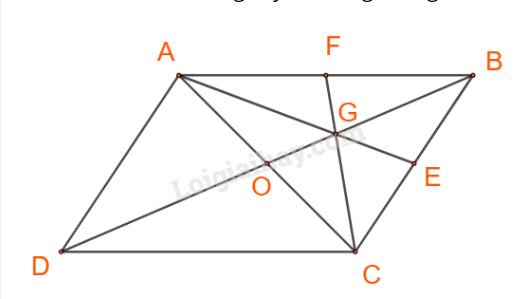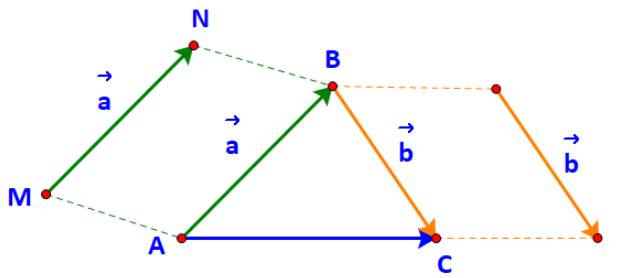cho các vecto \(\overrightarrow{a};\overrightarrow{b}\)có độ dài bằng 1 và 2 góc giữa 2 vecto bằng 120 độ. Ta lập vecto \(\overrightarrow{c}=3\overrightarrow{a}+4\overrightarrow{b}\). Tính độ dài của vecto \(\overrightarrow{c}\)

Những câu hỏi liên quan
Cho hai vecto overrightarrow{a} ( -3 ; 2 ) và overrightarrow{b} ( 4 ; 5 )a) Hãy biểu thị các vecto overrightarrow{a} và overrightarrow{b} theo hai vecto overrightarrow{i} vàoverrightarrow{j}b) Tìm tọa độ của các vecto overrightarrow{c} overrightarrow{a} - overrightarrow{b} , overrightarrow{d} 2overrightarrow{a}+ dfrac{1}{2}overrightarrow{b}
Đọc tiếp
Cho hai vecto \(\overrightarrow{a}\) = ( -3 ; 2 ) và \(\overrightarrow{b}\) = ( 4 ; 5 )
a) Hãy biểu thị các vecto \(\overrightarrow{a}\) và \(\overrightarrow{b}\) theo hai vecto \(\overrightarrow{i}\) và\(\overrightarrow{j}\)
b) Tìm tọa độ của các vecto \(\overrightarrow{c}\) = \(\overrightarrow{a}\) - \(\overrightarrow{b}\) ,
\(\overrightarrow{d}\) = 2\(\overrightarrow{a}\)+ \(\dfrac{1}{2}\)\(\overrightarrow{b}\)
Cho ba vecto overrightarrow{a},overrightarrow{b},overrightarrow{c} không đồng phẳng. Xét các vecto overrightarrow{x}2overrightarrow{a}+overrightarrow{b},overrightarrow{y}overrightarrow{a}-overrightarrow{b}-overrightarrow{c},overrightarrow{z}-3overrightarrow{b}-2overrightarrow{c}. Chọn khẳng định đúng?A. Ba vecto overrightarrow{x},overrightarrow{y},overrightarrow{z} đồng phẳng.B. Ba vecto đôi một cùng phương.C. Hai vecto overrightarrow{x},overrightarrow{b} cùng phương.D. Hai vecto overrightarrow{...
Đọc tiếp
Cho ba vecto \(\overrightarrow{a},\overrightarrow{b},\overrightarrow{c}\) không đồng phẳng. Xét các vecto \(\overrightarrow{x}=2\overrightarrow{a}+\overrightarrow{b},\overrightarrow{y}=\overrightarrow{a}-\overrightarrow{b}-\overrightarrow{c},\overrightarrow{z}=-3\overrightarrow{b}-2\overrightarrow{c}\). Chọn khẳng định đúng?
A. Ba vecto \(\overrightarrow{x},\overrightarrow{y},\overrightarrow{z}\) đồng phẳng.
B. Ba vecto đôi một cùng phương.
C. Hai vecto \(\overrightarrow{x},\overrightarrow{b}\) cùng phương.
D. Hai vecto \(\overrightarrow{x},\overrightarrow{a}\) cùng phương.
\(\overrightarrow{x}=2\overrightarrow{a}+\overrightarrow{b}=2\left(\overrightarrow{a}-\overrightarrow{b}-\overrightarrow{c}\right)-\left(-3\overrightarrow{b}-2\overrightarrow{c}\right)=2\overrightarrow{y}-\overrightarrow{z}\)
\(\Rightarrow\) 3 vecto đã cho đồng phẳng
Đúng 0
Bình luận (0)
Cho ba vecto overrightarrow{a},overrightarrow{b},overrightarrow{c} không đồng phẳng. Xét các vecto overrightarrow{x}2overrightarrow{a}+overrightarrow{b},overrightarrow{y}overrightarrow{a}-overrightarrow{b}-overrightarrow{c},overrightarrow{z}-3overrightarrow{b}-2overrightarrow{c}. Chọn khẳng định đúng?A. Ba vecto overrightarrow{x},overrightarrow{y},overrightarrow{z} đồng phẳng.B. Ba vecto đôi một cùng phương.C. Hai vecto overrightarrow{x},overrightarrow{b} cùng phương.D. Hai vecto overrightarrow{...
Đọc tiếp
Cho ba vecto \(\overrightarrow{a},\overrightarrow{b},\overrightarrow{c}\) không đồng phẳng. Xét các vecto \(\overrightarrow{x}=2\overrightarrow{a}+\overrightarrow{b},\overrightarrow{y}=\overrightarrow{a}-\overrightarrow{b}-\overrightarrow{c},\overrightarrow{z}=-3\overrightarrow{b}-2\overrightarrow{c}\). Chọn khẳng định đúng?
A. Ba vecto \(\overrightarrow{x},\overrightarrow{y},\overrightarrow{z}\) đồng phẳng.
B. Ba vecto đôi một cùng phương.
C. Hai vecto \(\overrightarrow{x},\overrightarrow{b}\) cùng phương.
D. Hai vecto \(\overrightarrow{x},\overrightarrow{a}\) cùng phương.
\(2\overrightarrow{y}-\overrightarrow{z}=2\overrightarrow{a}-2\overrightarrow{b}-2\overrightarrow{c}+3\overrightarrow{b}+2\overrightarrow{c}=2\overrightarrow{a}+\overrightarrow{b}=\overrightarrow{x}\)
\(\Rightarrow\) Ba vecto \(\overrightarrow{x},\overrightarrow{y},\overrightarrow{z}\) đồng phẳng
Đúng 1
Bình luận (0)
Cho các vecto \(\left|\overrightarrow{a}\right|=x,\left|\overrightarrow{b}\right|=y,\left|\overrightarrow{z}\right|=c\) và vecto a+b+3c=0. Tính \(A=\overrightarrow{a}.\overrightarrow{b}+\overrightarrow{b}.\overrightarrow{c}+\overrightarrow{c}.\overrightarrow{a}\)
\(\overrightarrow{a}+\overrightarrow{b}+3\overrightarrow{c}=\overrightarrow{0}\Leftrightarrow\overrightarrow{a}+\overrightarrow{b}+\overrightarrow{c}=-2\overrightarrow{c}\)
\(\Leftrightarrow\left(\overrightarrow{a}+\overrightarrow{b}+\overrightarrow{c}\right)^2=\left(-2\overrightarrow{c}\right)^2\)
\(\Leftrightarrow\overrightarrow{a}^2+\overrightarrow{b}^2+\overrightarrow{c}^2+2\left(\overrightarrow{a}.\overrightarrow{b}+\overrightarrow{b}.\overrightarrow{c}+\overrightarrow{c}.\overrightarrow{a}\right)=4\overrightarrow{c}^2\)
\(\Leftrightarrow A=\dfrac{4x^2-\left(x^2+y^2+z^2\right)}{2}=\dfrac{3x^2-y^2-z^2}{2}\)
Đúng 2
Bình luận (0)
Cho hình vuông ABCD có cạnh bằng a. Gọi M, N tương ứng là trung điểm của các cạnh AB, BC.
a) Biểu thị các vecto \(\overrightarrow {DM} ,\overrightarrow {AN} \) theo các vecto \(\overrightarrow {AB} ,\overrightarrow {AD} \)
b) Tính \(\overrightarrow {DM} .\overrightarrow {AN} \) và tìm góc giữa hai đường thẳng DM và AN.
a) Ta có:
\(\overrightarrow {DM} = \overrightarrow {DA} + \overrightarrow {AM} = - \overrightarrow {AD} + \frac{1}{2}\overrightarrow {AB} \) (do M là trung điểm của AB)
\(\overrightarrow {AN} = \overrightarrow {AB} + \overrightarrow {BN} = \overrightarrow {AB} + \frac{1}{2}\overrightarrow {BC} = \overrightarrow {AB} + \frac{1}{2}\overrightarrow {AD} \) (do N là trung điểm của BC)
b)
\(\begin{array}{l}\overrightarrow {DM} .\overrightarrow {AN} = \left( { - \overrightarrow {AD} + \frac{1}{2}\overrightarrow {AB} } \right).\left( {\overrightarrow {AB} + \frac{1}{2}\overrightarrow {AD} } \right)\\ = - \overrightarrow {AD} .\overrightarrow {AB} - \frac{1}{2}{\overrightarrow {AD} ^2} + \frac{1}{2}{\overrightarrow {AB} ^2} + \frac{1}{4}\overrightarrow {AB} .\overrightarrow {AD} \end{array}\)
Mà \(\overrightarrow {AB} .\overrightarrow {AD} = \overrightarrow {AD} .\overrightarrow {AB} = 0\) (do \(AB \bot AD\)), \({\overrightarrow {AB} ^2} = A{B^2} = {a^2};{\overrightarrow {AD} ^2} = A{D^2} = {a^2}\)
\( \Rightarrow \overrightarrow {DM} .\overrightarrow {AN} = - 0 - \frac{1}{2}{a^2} + \frac{1}{2}{a^2} + \frac{1}{4}.0 = 0\)
Vậy \(DM \bot AN\) hay góc giữa hai đường thẳng DM và AN bằng \({90^ \circ }\).
Đúng 0
Bình luận (0)
Cho ABCD là hình bình hành. Đặt \(\overrightarrow {AB} = \overrightarrow a ,\overrightarrow {AD} = \overrightarrow b .\) Gọi G là trọng tâm của tam giác ABC. Biểu thị các vecto \(\overrightarrow {AG} ,\overrightarrow {CG} \) theo hai vecto \(\overrightarrow a ,\overrightarrow b .\)
Cách 1:
Gọi O là giao điểm của AC và BD.

Ta có:
\(\begin{array}{l}\overrightarrow {AG} = \overrightarrow {AB} + \overrightarrow {BG} = \overrightarrow a + \overrightarrow {BG} ;\\\overrightarrow {CG} = \overrightarrow {CB} + \overrightarrow {BG} = \overrightarrow {DA} + \overrightarrow {BG} = - \overrightarrow b + \overrightarrow {BG} ;\end{array}\)(*)
Lại có: \(\overrightarrow {BD} =\overrightarrow {BA} + \overrightarrow {AD} = - \overrightarrow a + \overrightarrow b \).
\(\overrightarrow {BG} ,\overrightarrow {BD} \) cùng phương và \(\left| {\overrightarrow {BG} } \right| = \frac{2}{3}BO = \frac{1}{3}\left| {\overrightarrow {BD} } \right|\)
\( \Rightarrow \overrightarrow {BG} = \frac{1}{3}\overrightarrow {BD} = \frac{1}{3}\left( { - \overrightarrow a + \overrightarrow b } \right)\)
Do đó (*) \( \Leftrightarrow \left\{ \begin{array}{l}\overrightarrow {AG} = \overrightarrow a + \overrightarrow {BG} = \overrightarrow a + \frac{1}{3}\left( { - \overrightarrow a + \overrightarrow b } \right) = \frac{2}{3}\overrightarrow a + \frac{1}{3}\overrightarrow b ;\\\overrightarrow {CG} = -\overrightarrow b + \overrightarrow {BG} = -\overrightarrow b + \frac{1}{3}\left( { - \overrightarrow a + \overrightarrow b } \right) = - \frac{1}{3}\overrightarrow a - \frac{2}{3}\overrightarrow b ;\end{array} \right.\)
Vậy \(\overrightarrow {AG} = \frac{2}{3}\overrightarrow a + \frac{1}{3}\overrightarrow b ;\;\overrightarrow {CG} = - \frac{1}{3}\overrightarrow a - \frac{2}{3}\overrightarrow b .\)
Đúng 1
Bình luận (0)
Cách 2:
Gọi AE, CF là các trung tuyến trong tam giác ABC.

Ta có:
\(\overrightarrow {AG} = \frac{2}{3}\overrightarrow {AE} = \frac{2}{3}.\frac{1}{2}\left( {\overrightarrow {AB} + \overrightarrow {AC} } \right) = \frac{2}{3}.\frac{1}{2}\left[ {\overrightarrow {AB} + \left( {\overrightarrow {AB} + \overrightarrow {AD} } \right)} \right] \\= \frac{1}{3}\left( {2\overrightarrow a + \overrightarrow b } \right) = \frac{2}{3}\overrightarrow a + \frac{1}{3}\overrightarrow b \)
\(\overrightarrow {CG} = \frac{2}{3}\overrightarrow {CF} = \frac{2}{3}.\frac{1}{2}\left( {\overrightarrow {CA} + \overrightarrow {CB} } \right) = \frac{2}{3}.\frac{1}{2}\left[ {\left( {\overrightarrow {CB} + \overrightarrow {CD} } \right) + \overrightarrow {CB} } \right] = \frac{1}{3}\left( {2\overrightarrow {CB} + \overrightarrow {CD} } \right) = \frac{1}{3}\left( { - 2\overrightarrow {AD} - \overrightarrow {AB} } \right) = - \frac{1}{3}\overrightarrow a - \frac{2}{3}\overrightarrow b \)
Vậy \(\overrightarrow {AG} = \frac{2}{3}\overrightarrow a + \frac{1}{3}\overrightarrow b ;\;\overrightarrow {CG} = - \frac{1}{3}\overrightarrow a - \frac{2}{3}\overrightarrow b .\)
Đúng 0
Bình luận (0)
Cho hai vecto \(\overrightarrow a ,\overrightarrow b \). Lấy một điểm A tùy ý.
a) Vẽ \(\overrightarrow {AB} = a\), \(\overrightarrow {BC} = b\)
b) Tổng của hai vecto \(\overrightarrow a \) và \(\overrightarrow b \)bằng vecto nào?
a) Gọi M, N lần lượt là điểm đầu và điểm cuối của vecto \(\overrightarrow a \).
Vì \(\overrightarrow a = \overrightarrow {AB} \Leftrightarrow \overrightarrow {MN} = \overrightarrow {AB} \) nên tứ giác MNBA là hình bình hành.
Nói cách khác B là đỉnh thứ tư của hình bình hành tạo bởi vecto \(\overrightarrow a \) và điểm A.
Tương tự, C là đỉnh thứ tư của hình bình hành tạo bởi vecto \(\overrightarrow b \) và điểm B.

b) Dễ thấy: tổng của hai vecto \(\overrightarrow {AB} \) và \(\overrightarrow {BC} \) là vecto \(\overrightarrow {AC} \).
Do đó tổng của hai vecto \(\overrightarrow a \) và \(\overrightarrow b \)bằng vecto \(\overrightarrow {AC} \).
Ta có viết: \(\overrightarrow a + \overrightarrow b = \overrightarrow {AB} + \overrightarrow {BC} = \overrightarrow {AC} \)
Đúng 0
Bình luận (0)
Trong mặt phẳng tọa độ Oxy cho các vectơ overrightarrow{a} (2 , 5) , overrightarrow{b} (-1,4) , overrightarrow{c} (3,0)a, tìm toạ độ của các vecto sau overrightarrow{a} + overrightarrow{b} ,overrightarrow{b} - overrightarrow{c} , 5overrightarrow{a}b, hãy biểu diễn vectơ overrightarrow{a} theo hai vectơ overrightarrow{b} ,overrightarrow{c}c, cho x ( 3m ; 2m +1 ) , tìm số m sao cho overrightarrow{text{x}} cùng phương vectơ overrightarrow{a} + 2overrightarrow{c}
Đọc tiếp
Trong mặt phẳng tọa độ Oxy cho các vectơ \(\overrightarrow{a}\) = (2 , 5) , \(\overrightarrow{b}\)= (-1,4) , \(\overrightarrow{c}\)= (3,0)
a, tìm toạ độ của các vecto sau \(\overrightarrow{a}\) + \(\overrightarrow{b}\) ,\(\overrightarrow{b}\) - \(\overrightarrow{c}\) , 5\(\overrightarrow{a}\)
b, hãy biểu diễn vectơ \(\overrightarrow{a}\) theo hai vectơ \(\overrightarrow{b}\) ,\(\overrightarrow{c}\)
c, cho x = ( 3m ; 2m +1 ) , tìm số m sao cho \(\overrightarrow{\text{x}}\) cùng phương vectơ \(\overrightarrow{a}\) + 2\(\overrightarrow{c}\)
Trong mặt phẳng tọa độ Oxy cho \(\overrightarrow{a}=2\overrightarrow{i}\) , \(\overrightarrow{b}=-3\overrightarrow{j}\), \(\overrightarrow{c}=3\overrightarrow{i}-4\overrightarrow{j}\)
Phân tích vecto c theo hai vecto a và vecto b
Giả sử `\vec{c}=m\vec{a}+n\vec{b}`
`<=>(3;-4)=m(2;0)+n(0;-3)`
`<=>(3;-4)=(2m;-3n)`
`<=>{(m=3/2),(n=4/3):}`
`=>\vec{c}=3/2\vec{a}+4/3\vec{b}`
Đúng 2
Bình luận (0)


















